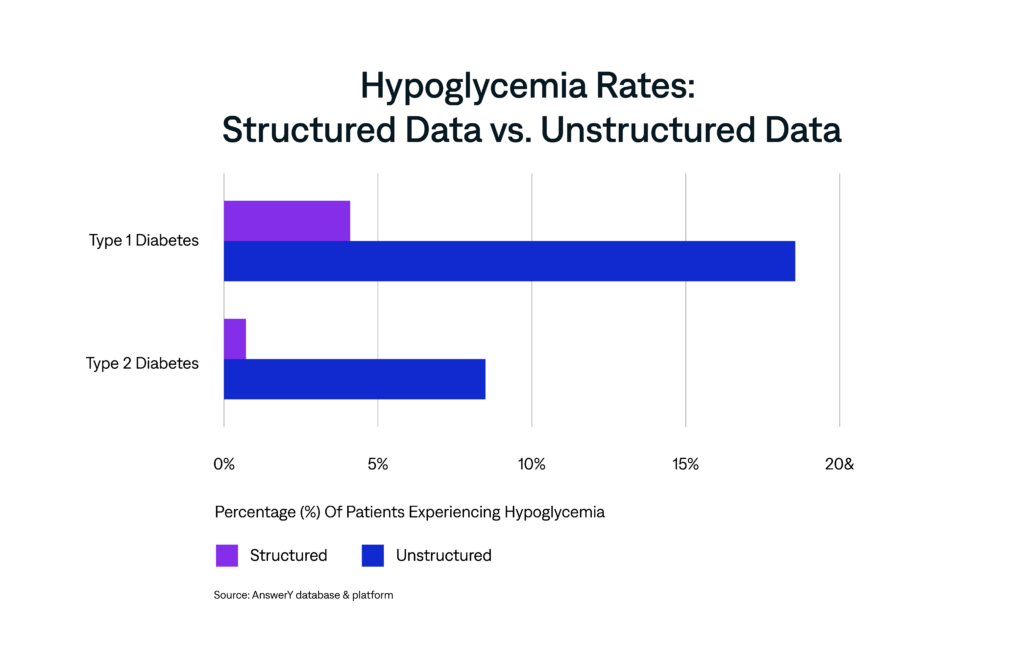Outsourcing global clinical
& medical engagement for accelerated drug approval
& acceptance
AnswerY™, an AI-driven, HIPAA-compliant platform of prescriber-patient conversations that drives next-best actions
Outsourcing global clinical
& medical engagement for accelerated drug approval
& acceptance

No image found.

Structured healthcare data is all about organization—think billing codes, insurance claims, and those rigid fields in electronic health records (EHRs). It’s great for standardization and reporting but doesn’t capture the complex reality of patient care. That’s because structured healthcare data relies on dropdown menus, checkboxes, and predefined fields that force everything into neat little boxes. But what happens when symptoms don’t fit? They get ignored. What about critical details buried in free-text notes? Overlooked.
As a result, this rigid approach creates massive blind spots, leaving healthcare providers (HCPs) without the complete picture they need to make informed decisions about patient care. It’s especially problematic for conditions like hypoglycemia, where subtle symptoms or patient-reported details often slip through the cracks. Sure, structured data is efficient, but it simply cannot capture the complexity and nuances of real-world patient care. That’s where analyzing unstructured medical data comes in—unlocking the critical insights hidden in free-text notes, transcription records, and patient-provider conversations.
Unstructured healthcare data is the unfiltered, messy side of healthcare—and that’s exactly what makes it so powerful. For example, unstructured healthcare data includes items like physician notes, transcription records, and patient-provider interactions. It’s where the real details live: the context, the nuance, and the insights that don’t fit neatly in a dropdown menu. Sure, it’s not a tidy box, but analyzing unstructured medical data is the key to uncovering patterns that structured data misses. For example, unstructured data can reveal why a treatment was started, stopped, or switched. These are the kinds of details that tell the “why” behind patient care decisions—critical information for improving outcomes.
Did you know that 80% of healthcare data is unstructured, according to Healthcare Tech Outlook? Imagine the amount of intel you can get from sources like include medical transcriptions, medical images, and discharge summaries.
Due to its level of dimension and detail, when analyzed, unstructured healthcare data can reveal trends that structured data just can’t, like why a physician adjusted a patient’s medication or why a specific therapy was discontinued. Ultimately, these rich insights can empower healthcare providers to make smarter, more personalized decisions—and improve patient outcomes.
Natural language processing (NLP) is a game-changer for healthcare. This AI-powered technology helps interpret and analyze unstructured medical data, turning messy, free-text information into actionable insights.
NLP is key to analyzing unstructured medical data, which often holds critical details that structured datasets, like claims or EHRs, often miss. By extracting meaning from unstructured healthcare data, NLP empowers HCPs to uncover deeper insights and make smarter decisions.
AI-powered platform Amplity AnswerY™ uses NLP to mine over 80 million HIPAA-compliant patient-provider interactions, which helps uncover the “why” behind treatment decisions, like starting or stopping medications. And by turning this data into patterns and trends, NLP gives HCPs a more complete picture of patient care and helps improve outcomes across the board.
A recent study, “Assessing Prevalence of Hypoglycemia in a Medical Transcription Database,” shows the value of unstructured data. It also demonstrates how traditional data sources often miss the full picture when it comes to hypoglycemia. However, analyzing unstructured medical data tells a different story.
In this analysis, AnswerY used NLP to dig into medical transcriptions detailing provider-patient encounters. The results? Hypoglycemia rates were significantly higher than previously reported.
This means hypoglycemia rates were 2 to 9 times higher in unstructured data than in structured datasets like claims or EHRs.

Unstructured healthcare data not only fills the gaps in traditional datasets but also provides a more comprehensive understanding of patient health. It helps uncover discrepancies, like mentions of hypoglycemia during a healthcare visit that aren’t documented in the patient’s records. Furthermore, it helps tell the full story, which can help pave the way to better care.
The Amplity AnswerY platform is changing how we analyze unstructured medical data. Powered by advanced NLP, this HIPAA-compliant platform extracts meaningful insights from tens of millions of doctor-patient conversations.
Here’s just a few things make AnswerY so unique:
AnswerY doesn’t just explain why therapies are started, adjusted, or stopped—it provides actionable insights that fuel smarter sales, marketing, medical and RWD strategies. With AnswerY, biopharma companies gain a clearer understanding of real-world patient care, enabling faster, more personalized treatments.
Learn how AnswerY provides clear answers behind HCP decisions.
The future of pharma lies in the combination of structured and unstructured healthcare data. Structured data, provides standardized, critical information. But it’s unstructured medical data—physician notes, patient conversations, and free-text records—that holds the context and nuance needed for a complete picture.
With NLP-powered tools like AnswerY, analyzing unstructured medical data is easier than ever. It transforms messy, unfiltered information into meaningful insights, uncovering trends and patterns that would otherwise go unnoticed.
While both data types have their advantages, unstructured healthcare data is what will ultimately put insights into action across sales, marketing, medical, and RWD teams.
Dig Deeper: Contact us to see what insights you’re missing.